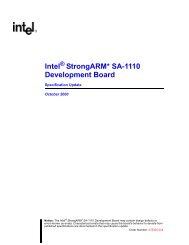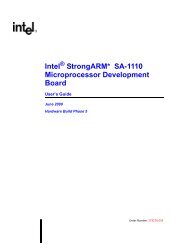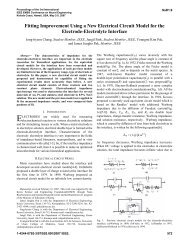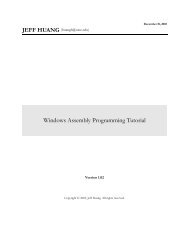Beej's Guide to Network Programming Using Internet Sockets
Beej's Guide to Network Programming Using Internet Sockets
Beej's Guide to Network Programming Using Internet Sockets
- No tags were found...
Create successful ePaper yourself
Turn your PDF publications into a flip-book with our unique Google optimized e-Paper software.
Beej’s <strong>Guide</strong> <strong>to</strong> <strong>Network</strong> <strong>Programming</strong> <strong>Using</strong> <strong>Internet</strong> <strong>Sockets</strong> 42. What is a socket?You hear talk of “sockets” all the time, and perhaps you are wondering just what they areexactly. Well, they’re this: a way <strong>to</strong> speak <strong>to</strong> other programs using standard Unix file descrip<strong>to</strong>rs.What?Ok–you may have heard some Unix hacker state, “Jeez, everything in Unix is a file!” Whatthat person may have been talking about is the fact that when Unix programs do any sort of I/O,they do it by reading or writing <strong>to</strong> a file descrip<strong>to</strong>r. A file descrip<strong>to</strong>r is simply an integer associatedwith an open file. But (and here’s the catch), that file can be a network connection, a FIFO, a pipe,a terminal, a real on-the-disk file, or just about anything else. Everything in Unix is a file! So whenyou want <strong>to</strong> communicate with another program over the <strong>Internet</strong> you’re gonna do it through a filedescrip<strong>to</strong>r, you’d better believe it.“Where do I get this file descrip<strong>to</strong>r for network communication, Mr. Smarty-Pants?” isprobably the last question on your mind right now, but I’m going <strong>to</strong> answer it anyway: You makea call <strong>to</strong> the socket() system routine. It returns the socket descrip<strong>to</strong>r, and you communicatethrough it using the specialized send() and recv() (man send 3 , man recv 4 ) socket calls.“But, hey!” you might be exclaiming right about now. “If it’s a file descrip<strong>to</strong>r, why in thename of Neptune can’t I just use the normal read() and write() calls <strong>to</strong> communicate throughthe socket?” The short answer is, “You can!” The longer answer is, “You can, but send() andrecv() offer much greater control over your data transmission.”What next? How about this: there are all kinds of sockets. There are DARPA <strong>Internet</strong>addresses (<strong>Internet</strong> <strong>Sockets</strong>), path names on a local node (Unix <strong>Sockets</strong>), CCITT X.25 addresses(X.25 <strong>Sockets</strong> that you can safely ignore), and probably many others depending on which Unixflavor you run. This document deals only with the first: <strong>Internet</strong> <strong>Sockets</strong>.2.1. Two Types of <strong>Internet</strong> <strong>Sockets</strong>What’s this? There are two types of <strong>Internet</strong> sockets? Yes. Well, no. I’m lying. There aremore, but I didn’t want <strong>to</strong> scare you. I’m only going <strong>to</strong> talk about two types here. Except for thissentence, where I’m going <strong>to</strong> tell you that “Raw <strong>Sockets</strong>” are also very powerful and you shouldlook them up.All right, already. What are the two types? One is “Stream <strong>Sockets</strong>”; the other is “Datagram<strong>Sockets</strong>”, which may hereafter be referred <strong>to</strong> as “SOCK_STREAM” and “SOCK_DGRAM”, respectively.Datagram sockets are sometimes called “connectionless sockets”. (Though they can beconnect()’d if you really want. See connect(), below.)Stream sockets are reliable two-way connected communication streams. If you output twoitems in<strong>to</strong> the socket in the order “1, 2”, they will arrive in the order “1, 2” at the opposite end.They will also be error free. Any errors you do encounter are figments of your own deranged mind,and are not <strong>to</strong> be discussed here.What uses stream sockets? Well, you may have heard of the telnet application, yes? It usesstream sockets. All the characters you type need <strong>to</strong> arrive in the same order you type them, right?Also, web browsers use the HTTP pro<strong>to</strong>col which uses stream sockets <strong>to</strong> get pages. Indeed, if youtelnet <strong>to</strong> a web site on port 80, and type “GET / HTTP/1.0” and hit RETURN twice, it’ll dumpthe HTML back at you!3 http://man.linuxquestions.org/index.php?query=send§ion=2&type=24 http://man.linuxquestions.org/index.php?query=recv§ion=2&type=2












